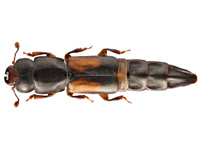Abstract
Several decades ago, Vanzolini (1991) described Amphisbaena arenaria Vanzolini, 1991 based on a single individual (MZUSP 65817) collected at Raso da Catarina, a large flat sandy deposit at the southern bank of São Francisco River. In the same paper he described A. frontalis Vanzolini, 1991 based on specimens collected at another sandy area, at the northern bank of São Francisco River, both in Bahia state, Brazil. As conflicting values are presented throughout his paper, the diagnosis of A. arenaria still needs clarification. We here comment on these differences and re-diagnose A. arenaria including new topotypic material, providing its phylogenetic placement and a new state record.
References
Almeida, J.P.F.A.D., Dal Vechio, F., Teixeira, M.. Jr, Rodrigues, M.T. & Mott, T. (2016) Morphological similarities between Amphisbaena mitchelli Procter, 1923 and A. miringoera Vanzolini, 1971 (Squamata: Amphisbaenidae): phylogenetic relatedness or morphological convergence? Zootaxa, 4168 (3), 573–576.
http://dx.doi.org/10.11646/zootaxa.4168.3.9
Costa, H.C. & Bérnils, R.S. (2015) Répteis brasileiros: Lista de espécies 2015. Herpetologia Brasileira, 4, 75–93.
Darriba, D., Taboada, G.L., Doallo, R. & Posada, D. (2012) jModelTest 2: more models, new heuristics and parallel computing. Nature Methods, 9, 772–772.
http://dx.doi.org/10.1038/nmeth.2109
Edgar, R.C. (2004) MUSCLE: multiple sequence alignment with high accuracy and high throughput. Nucleic Acids Research, 32, 1792–1797.
http://dx.doi.org/10.1093/Nar/Gkh340
Gans, C. & Alexander, A.A. (1962) Studies on Amphisbaenids (Amphisbaenia, Reptilia). 2. On the Amphisbaenids of the Antilles. Bulletin of the Museum of Comparative Zoology, 128, 65–158.
Garda, A.A., Costa, T.B., Santos-Silva, C., Mesquita, D.O., Faria, R.G., Conceição, B.M., Silva, I.R.S., Ferreira, A.S., Rocha, S.M., Palmeira, C.N.S., Rodrigues, R., Ferrari, S.F. & Torquato, S. (2013) Herpetofauna of protected areas in the Caatinga I: Raso da Catarina Ecological Station (Bahia, Brazil). Check List, 9, 405–414.
http://dx.doi.org/10.15560/9.2.405
Kearney, M. & Stuart, B.L. (2004) Repeated evolution of limblessness and digging heads in worm lizards revealed by DNA from old bones. Proceedings of the Royal Society B-Biological Sciences, 271, 1677–1683.
http://dx.doi.org/10.1098/rspb.2004.2771Macey, J.R., Papenfuss, T.J., Kuehl, J.V., Fourcade, H.M. & Boore, J.L. (2004) Phylogenetic relationships among amphisbaenian reptiles based on complete mitochondrial genomic sequences. Molecular Phylogenetics and Evolution, 33, 22–31.
http://dx.doi.org/10.1016/j.ympev.2004.05.003Mott, T. & Vieites, D.R. (2009) Molecular phylogenetics reveals extreme morphological homoplasy in Brazilian worm lizards challenging current taxonomy. Molecular Phylogenetics and Evolution, 51, 190–200.
http://dx.doi.org/10.1016/j.ympev.2009.01.014
Palumbi, S.R. (1996) Nucleic acids II: The Polymerase Chain Reaction. In: Hillis, D.M., Moritz, C. & Mable, B.K. (Eds.), Molecular Systematics. Sinauer, Sunderland, MA, pp. 205–247.
Rodrigues, M.T. (2003) Herpetofauna da Caatinga. In: Leal, I.R., Tabarelli, M. & Silva, J.M.C. (Eds.), Ecologia e Conservaçao da Caatinga. Universidade Federal de Pernambuco, Recife, pp. 181–236.
Ronquist, F., Teslenko, M., van der Mark, P., Ayres, D.L., Darling, A., Höhna, S., Larget, B., Liu, L., Suchard, M.A. & Huelsenbeck, J.P. (2012) MrBayes 3.2: Efficient Bayesian Phylogenetic Inference and Model Choice across a Large Model Space. Systematic Biology, 61, 539–542.
http://dx.doi.org/10.1093/sysbio/sys029Tamura, K., Stecher, G., Peterson, D., Filipski, A. & Kumar, S. (2013) MEGA6: Molecular Evolutionary Genetics Analysis Version 6.0. Molecular Biology and Evolution, 30, 2725–2729.
http://dx.doi.org/10.1093/molbev/mst197Teixeira, M. Jr, Dal Vechio, F., Mollo-Neto, A. & Rodrigues, M.T. (2014) A New Two-Pored Amphisbaena Linnaeus, 1758, from Western Amazonia, Brazil (Amphisbaenia: Reptilia). South American Journal of Herpetology, 9, 62–74.
http://dx.doi.org/10.2994/SAJH-D-14-00004.1
Vanzolini, P.E. (1991) Two further new species of Amphisbaena from the semi-arid Northeast of Brasil (Reptilia, Amphisbaenia). Papéis Avulsos de Zoologia, 37, 347–361.
Vanzolini, P.E. (2002) An aid to the identification of the South American species of Amphisbaena (Squamata, Amphisbaenidae). Papéis Avulsos de Zoologia, 42, 351–362.
http://dx.doi.org/10.1590/S0031-10492002001500001
Vieites, D.R., Min, M.S. & Wake, D.B. (2007) Rapid diversification and dispersal during periods of global warming by plethodontid salamanders. Proceedings of the National Academy of Sciences, 104, 19903–19907.
http://dx.doi.org/10.1073/pnas.0705056104

